Where your content or brand ranks on search engine results pages is crucial to drive traffic and generate leads.
If you get a spot on the first page of SERPs then that’s an achievement, but it’s the #1 spot that companies want.
So it’s important to use every tactic you can to try and get there. That’s where Google’s E-E-A-T (Experience, Expertise, Authoritativeness, and Trustworthiness) comes in.
While it’s not a ranking factor in Google’s algorithm, it is used to assess the quality of your content and plays an important role in where it ranks.
In this blog, we’ll explore E-E-A-T (and YMYL), the role of artificial intelligence in search, and look at how you can improve both to boost search engine optimization (SEO) and rank higher on Google.
- What is E-E-A-T?
- Why is E-E-A-T important?
- How does Google evaluate E-E-A-T?
- What is YMYL?
- What about E-E-A-T and AI-Generated content?
- How can you improve E-E-A-T?
Quick Guide - 12 Ways Digital Marketers Can Use ChatGPT
Download FreeWhat is E-E-A-T?
Originally, Google’s quality rating was E-A-T (Expertise, Authoritativeness, and Trustworthiness). The extra E for ‘Experience’ was added in 2022 to include experience in ranking content.
E-E-A-T is part of Google’s Search Quality Rater Guidelines. These are used by people called quality raters to evaluate content based on three factors: page quality, understanding user needs, and meeting user needs.
The feedback from raters helps the search engine measure the success of algorithm updates.
Let’s look at each E-E-A-T element in more detail:
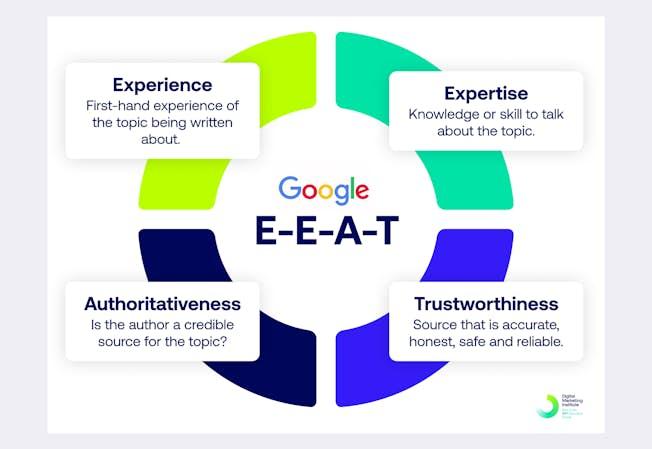
E- Experience
Does the content creator have first-hand or life experience on the topic they are writing about? For example, people are more likely to trust a review from someone who has used a product than someone who has not. Here’s an example from Medium on the apps this author has used to make his day-to-day life easier.
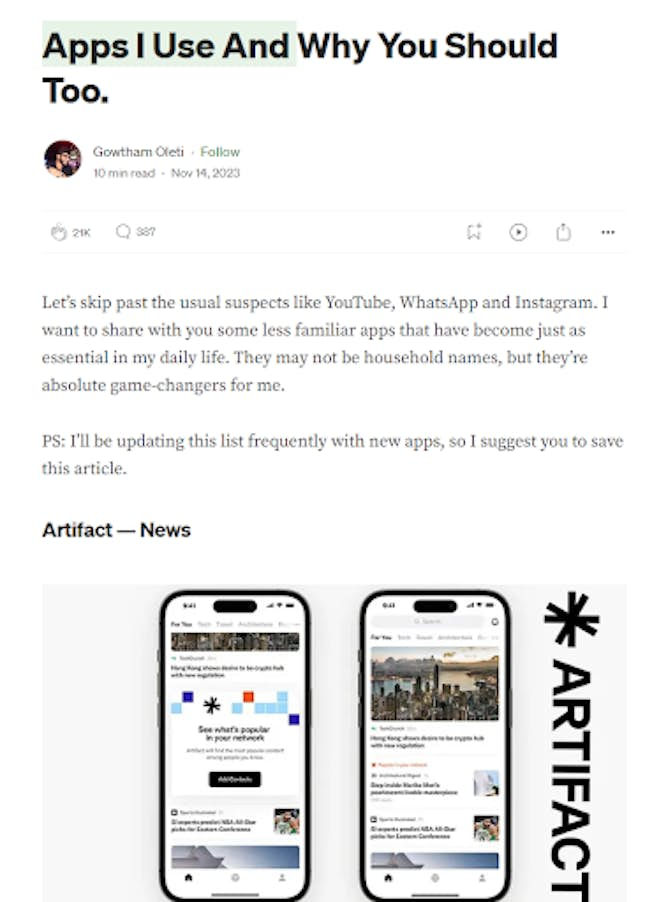
E - Expertise
Does the creator of the content have the knowledge or skill to talk about the topic? For example, when it comes to fixing a leak, people are more likely to trust content from a plumber than an enthusiast with little experience. Here’s an example from a recent DMI podcast with marketing great Rand Fishkin that shows his level of expertise to talk about understanding an audience.
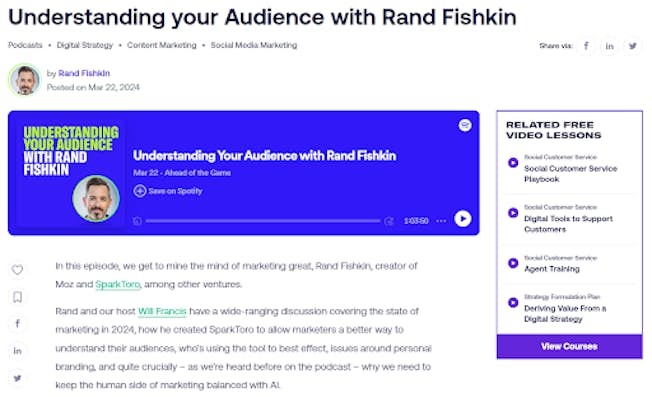
A - Authoritativeness
Is the website or page known as a go-to source for the topic? For example, if someone wants to find out about the latest fashion trends, a site like Vogue, as opposed to a blog from a fashion enthusiast, would be deemed an authority.

T - Trustworthiness
Trustworthiness is at the core of E-E-A-T and the most important factor to consider. In analyzing trustworthiness, quality raters look at the creator, content, and website. This is why it’s so important for facts to be accurate, and for the author to be reputable and include trustworthy sources. (High-authority sites are a good place to start, such as the New York Times).

In addition, it’s important for the site itself to be trustworthy, such as being secure for shopping or including data privacy guidelines. Here’s an example of a privacy and cookie policy from the media site TechCrunch.
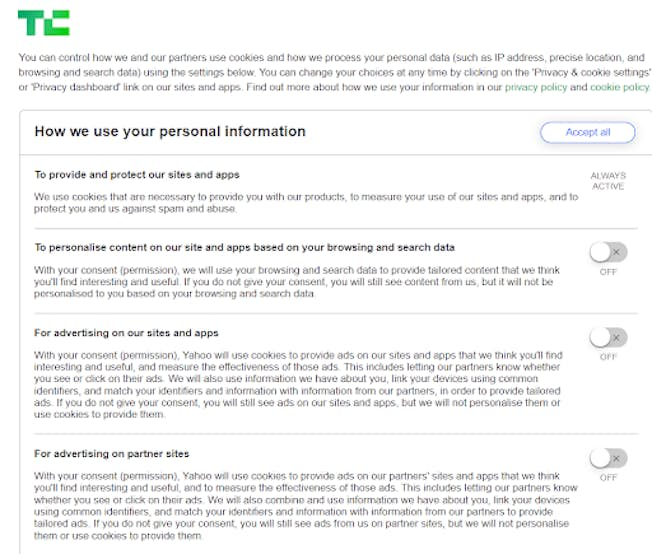
Why is E-E-A-T important?
Google and other search engines want to find content that people find valuable. They want to provide users with a good user experience that gives credible and useful answers to what they are searching for. These users are then more likely to use those search engines again.
This is evident in the regular algorithm updates, Google’s new AI-powered Search Generative Experience (SGE), and inclusion of ‘experience’ in E-E-A-T.
According to Google’s guidelines, Experience, Expertise, Authoritativeness, and Trustworthiness (E-E-A-T) are all important considerations in page quality rating. The most important member of the E-E-A-T family is Trustworthiness.
The core of E-E-A-T is content that Google rates as trustworthy due to a combination of expertise, experience, and authority.
“Google added ‘Experience’ as another ‘E’ so they're clearly big on experience and reluctant to recommend rubbish websites in their search results as it rubs off on their reputation,” said Luke O 'Leary, VP at Neil Patel Digital on a recent DMI podcast.
How does Google evaluate E-E-A-T?
Google’s quality raters use levels to rank E-E-A-T. These are as follows:
- Lowest: These pages fall into three categories: harmful, untrustworthy, and spammy.
- Lacking: Pages in this category are seen as low quality as they lack expertise, experience, or authority for the topic or purpose of the page but are not harmful. For example, it could be a blog written about flying a plane but the writer has no experience in doing that.
- High level: These pages offer significant amounts of expertise, credibility, and trustworthiness to serve a purpose and achieve it well. Google looks at the level of effort, level of talent or skill, and originality, along with a positive reputation.
- Very high level: The highest ranking pages are those that show evidence of a high level of effort, originality, talent, or skill. This would include people who demonstrate extensive hands-on knowledge of the topic they are writing about.
Below is an example with the highest quality justification listed in Google’s guidelines as: ‘very positive website reputation for the topic of the page, very high E-E-A-T for the purpose of the page and YMYL topic.’
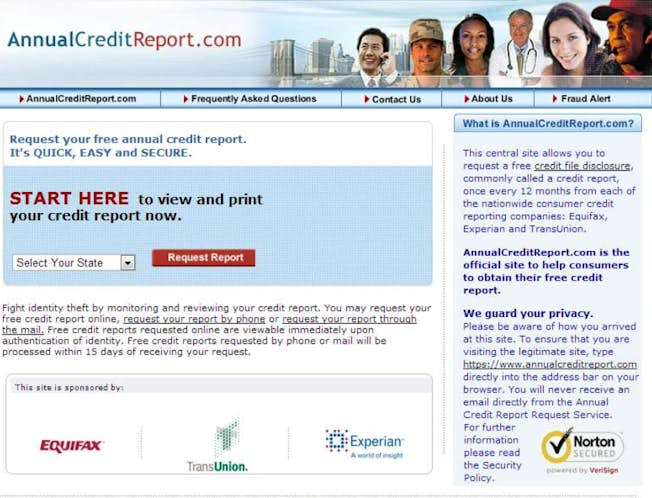
What is YMYL?
Another thing you should look at, alongside E-E-A-T, is ‘Your Money or Your Life’ (YMYL).
Google classes web pages as YMYL when the content has the potential to impact a person’s happiness, health, financial stability, or safety. This includes content that focuses on current events and news, finance, government and law, health and safety, and shopping.
Examples of YMYL content could be: how to fill out a tax form, how to save for retirement, or how to treat bowel cancer.
This page from the Centers for Disease Control and Prevention about measles detection is a good YMYL example.
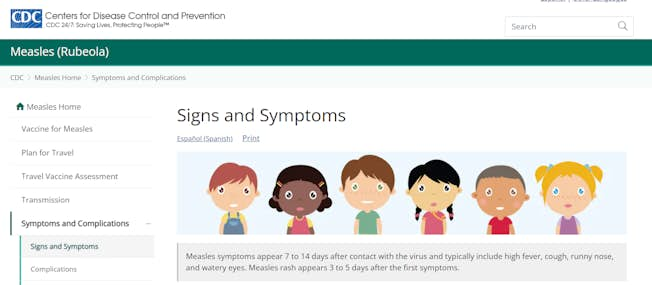
Google’s quality raters have high page quality rating standards for YMYL pages because their content can affect the user.
What about E-E-A-T and AI-generated content?
Google does not currently label AI-generated content. However, it does recommend that content publishers label AI-generated images using IPTC image data metadata, and adds that image AI companies will soon add the metadata automatically.
For text-based content, Google is leaving it up to publishers to decide whether they label AI content. But, at a recent conference, the search engine giant did say that its algorithms and signals are based on human content, so it will rank natural (or human-created) content at the top.
Note: This could change as Google looks to create an AI policy, so it’s important to keep an eye on developments.
How can you improve E-E-A-T?
As you can see, improving your E-E-A-T can help optimize your content and boost your SEO efforts. It can also help you to create quality content that’s relevant and useful to your target audience.
So how can you improve your E-E-A-T? Here are six tips.
1. Fill knowledge gaps
If you understand your audience,you should know what they are looking for online.
Once you’ve covered the core topics that relate to your product or service, what else can you write about?
That’s where you need to be clever about your content marketing strategy and look for gaps that your competitors are not filling. Is there an in-house expert who has an interesting perspective on a popular topic? Or, have you come across customer feedback looking for information on a topic?
For example, let’s say you work for a makeup company. You’ve probably already created content around the benefits of the products or advice on how to look after skin. But what about content that maps out a beauty routine based on skin type? This could be an infographic or mini ebook that you can use for data capture.
You can come up with new content ideas through brainstorming or use a tool like Semrush’s Topic Research Tool or AnswerThePublic.
Top tip: Gossip websites, fashion websites, and fan forums can show evidence of high E-E-A-T. In addition, some types of information are found almost exclusively on forums and discussions, where a community of experts can provide valuable perspectives on topics.
2. Add and refresh content
Google loves new content as it shows that your site is maintained regularly. The regularity of your content will depend on the type that you create.
If your company is known for big research publications, then your content schedule should reflect that. However, if you produce informative blogs or weekly webinars, then you should post more frequently to reflect that and keep your audience up to date.
Don’t just leave your existing content untouched. Content can go out of date quickly, particularly if it’s based on trends or uses statistics. You should conduct a content audit to see how existing content is performing.
Following an audit, you should look to optimize top-performing content or content your audience finds valuable to give it a refresh. Google will see that you have updated the content and reward you for your efforts.
3. Work with experts
It doesn’t matter what size the company you work for is, it’s always beneficial to work with experts to generate original content that feeds into E-E-A-T.
This could be in-house staff with in-depth knowledge of a particular area or an external expert who can provide a new perspective or angle on a topic relevant to your business.
At DMI, we regularly partner with many experts, including some from Neil Patel Digital on podcasts, blogs, and webinars. This provides our members and students with up-to-date and practical knowledge and also helps boost brand awareness and generate leads.
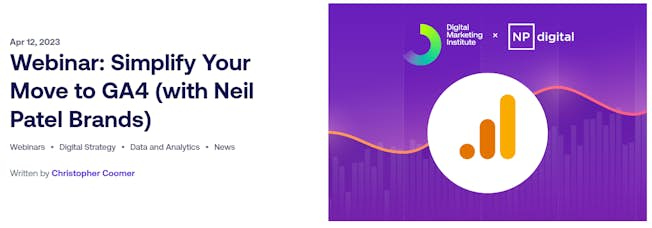
There are many content formats you can use to collaborate with experts, such as:
- A guest blog
- Webinar interview
- Podcast interview
- Quotes in a blog
- Whitepaper
- Ebook or guide
However, it’s important to choose an ‘expert’ that Google will recognize. This can be done by looking at the expert’s E-E-A-T signals, such as a social media profile, personal blog or site, author credentials (e.g. New York Times bestsellers), or online publications.
Top tip: You can also consider using influencers who are aligned with your brand and have a following that matches your target audience. If you pick the right influencer and develop the right content, you can get on the radar of high-intent customers and feed into E-E-A-T.
4. Use links to build connections
If you produce a lot of content, you will find that you will write about a set of key topics that matter to your audience.
While it’s important to have top-performing content pieces, it’s also important to link them to other relevant content. This can be done strategically by using a hub-and-spoke (or content pillars) model.
This model means that you have ‘hub’ topics (such as social media or SEO) that you link to a series of related posts, or ‘spokes’ (that could be more in-depth pieces about social media or SEO).
For example, let’s say you focus on social media as a topic. Your hub could be ‘What are the most popular social media channels?’ From that, you could create several articles that focus on each social platform such as TikTok, Facebook, and so on. You could then add another layer that focuses on specialist topics such as social media algorithms or content creators. These other articles are the spokes that branch out from your hub article.
By using this model, you are developing authority on the topic. Including internal links from the hub to each spoke and amongst the spokes can help feed into E-E-A-T.
Top tip: Make sure you are using clear anchor text when linking your content to clarify exactly what other content a link is going to. You can check if your existing links use anchor text by using a site audit tool.
5. Manage & monitor brand reputation
Trustworthiness is at the core of E-E-A-T, so it’s important to have a positive reputation online. Conversely, if you have a negative reputation, you should do something about it because it will affect your credibility and SERP rankings.
You can monitor your brand reputation through Google or review sites like Trustpilot and Yelp. Forums such as Reddit and Quora can also be scanned for brand mentions, while social media platforms are commonly used for customers to air their views – positive and negative.
The key to building a positive reputation is to respond to customers across channels.
- If it’s a positive review, thank the person for leaving it and consider asking them for a testimonial you can use for social proof.
- If someone leaves a negative review or comment, respond and ask them what you can do to solve the issue, or apologize if it’s a complaint about a product or service.
Top tip: Set up a Google Business Profile to give details about a business such as location, opening hours, and so on. There is also a review section you can manage and monitor.
6. Focus on customer experience (CX)
Customer experience is crucial for Google. It’s the bread and butter of its business because its goal is to feed into search intent to direct people to valuable and credible content that meets their needs.
A big part of that is the customer journey. On the DMI podcast, Luke O’Leary indicates that brands need to align with what users expect from clicking a search result. So if a user clicks on a link to a blog, they need to be led directly to that blog and see the content they expected based on the content in the SERP.
“Site experience optimization is really the future because that's what Google is focused on. Evolve your website for experience to take control and lead people to interact with your brand and pages more.” Luke O'Leary on the DMI Podcast
For example, O’Leary worked with a finance client and tested putting existing videos on its pages. “We found that people would spend over twice as much on the page. We went from one page per visit to three. People were interacting with the site and brand far more because they felt a connection and felt there was just a better experience.”
Top tip: Familiarize yourself with Core Web Vitals to understand how to optimize your website to deliver a better online experience.
Use SEO to attract, engage, and convert
Creating content that matches search intent is crucial to getting seen online. Our certified Search Marketing course developed with Neil Patel will help you understand the fundamentals of search marketing. It explores SEO, paid search, analytics, demand generation, search strategy, and much more. Get started today!
Upgrade to Power Membership to continue
your access to thousands of articles, toolkits, podcasts, lessons and much much more.
Become a Power Member- Login
- View Courses
- - - -
- Courses
- Resources
- - - -
- My Account
- Change Password
- Logout





